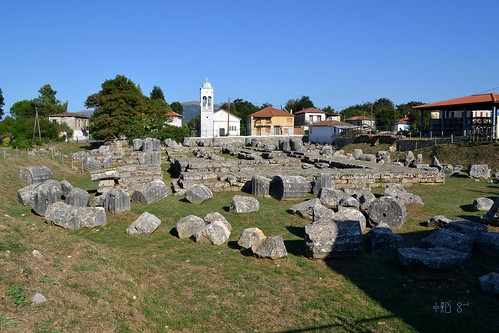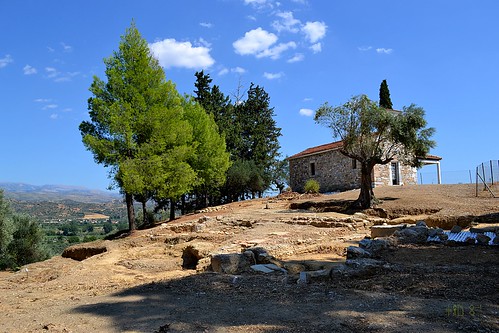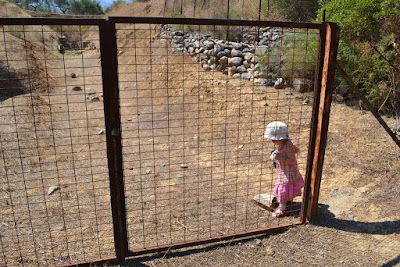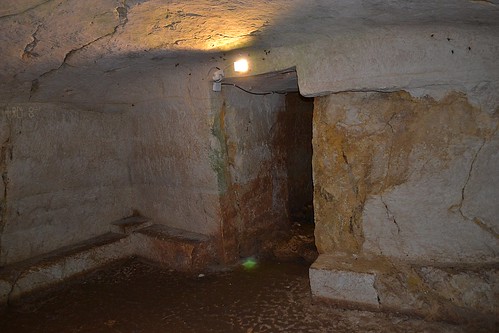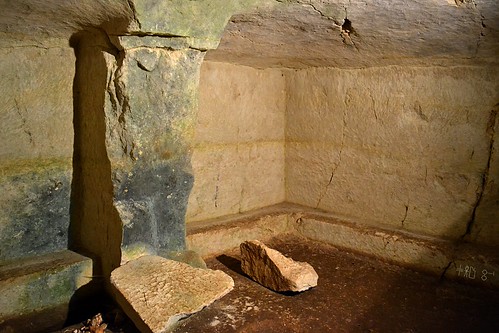Off the road to Arcadia, north of Sparta lies the village of Pellana. A dot on today’s map, but for the excavations which have brought to light heavy bronze-age occupation and a rather fine set of chamber tombs built into a hill. These chamber tombs somewhere at some time by someone were called Tholos Tombs and most of the references to the cemetery on the internet refer to Tholos Tombs of Pellana, (so that must be right, yeah?)
Unfortunately, no.
The Tholos Tomb form, θολωτός τάφος, is a very specific funerary structure with a built chamber.
 |
| Entrance signpost |
Just because the shape of the burial chamber mimics the Tholos form, it does not make the tombs in this cemetery Tholos Tombs, regardless of what the excavators and local ephorate would have you believe or
what the expatriate community in the states would have you believe. This link directs to one such expatriate site which is scarily wrong in almost everything it presents as fact – perhaps interesting for those modern day analysts of urban folklore (or even the texts of Pausanias and Herodotus), in that it tells the story the writer has believed and which readers will find plausible in the absence of conflicting, more authoritative information but which is based on second and third hand “facts” from local people who are more concerned with impressing the visitor with their superlatives than proving factual information.
So, setting aside all the crazy where was ancient Lakedaimon and this was Menelaos’ palace stuff, let’s get on to discuss the cemetery itself.
As you can see from the image above, the cemetery is signposted and fenced in standard fashion, with the cheeky hole (πονηρή τρυπούλα) to the right of the main entrance (if I am not mistaken). Following the ridge to the right takes the visitor above the main tombs, the largest one of which has been covered with a rather funny octagonal pagoda structure.
 |
| Octagonal pagoda, over the Large, so called Royal Tomb, at the Pellana LH chamber tomb cemetery |
The tombs were excavated in the period from 1926 to the late eighties. All had been plundered in antiquity and many had fallen in subsequent to this. The standard practice, as shown in the image below, seems to have been the interment in unlined pits in the floor of the chamber.
 |
| One of the tombs, from above, showing burial pits |
The large grave, image below also had pits in the chamber floor. It has a diameter of about 10m, making it one of the largest known LH chamber tombs.
 |
| The large, so called Royal Tomb, at Pellana |
I rather like the way the bedrock from which the tomb was excavated shows the geological bedding in this photo:
 |
| Bedrock stripes on the dromos of the large Chamber Tomb |
We did not follow-through with a visit to the Palace, mainly due to time constraints. Ariadne was sleeping and we decided to press on to Alea... It should be noted that at the time of our visit, no doubt because of the preparations for the new Tripolis/Sparta road the road system in the area was very difficult to navigate with roads stopping without warning and much doubling back on ourselves.
